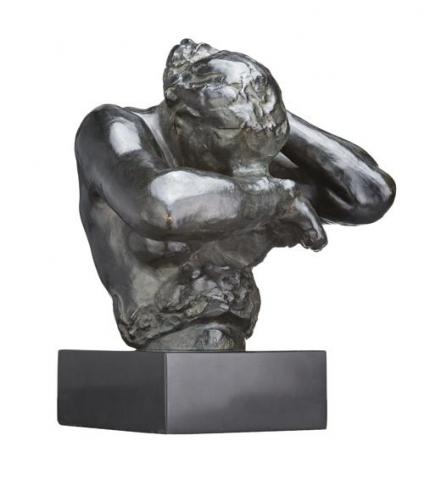ETUDE DE BUSTE POUR EVE, 1881
Auguste Rodin
22.9 cm height
Edition of 8 cast by the Coubert in Foundry in 1982
signed and numbered at base: A. Rodin no 6/8
inscribed with foundry mark at base
inscribed at base: © by Musée Rodin, 1982
Musée Rodin, Paris
Acquired from the above by the grandmother of thepresent owner
Private collection, Melbourne
In August 1880, Edmond Turquet, the newly appointed Under Secretary of Fine Arts and a keen admirer of Rodin's work, commissioned the French sculptor to create a monumental portal for the proposed Musée des Arts Décoratifs (to be erected on the site where the Musée d'Orsay is located today). Drawing inspiration from his recent experience in Italy, and particularly Lorenzo Ghiberti's celebrated Gates of Paradise at the Baptistery of St John in Florence, Rodin promptly submitted ideas for a vast composition loosely based upon Dante's epic literary masterpiece, The Divine Comedy. Although plans for the museum were never realised, Rodin would continue to work on his vision for The Gates of Hell over the next three decades until his death in 1917, isolating, modifying and recombining each of the main characters to create some of the most acclaimed works of his entire oeuvre, including The Thinker (initially intended to represent Dante himself, contemplating the fate of the protagonists below) and The Kiss (featuring the passionate embrace of Paola and Francesca, the lovers of the fifth canto condemned for their sins of the flesh).
Destined originally to flank the Gates, the life-size statues of Adam and Eve were first among the sculptures for the commission to be remodeled as independent figures. Bearing strong stylistic affinities with Michelangelo's interpretations for the Sistine Chapel ceiling - Adam stretches his index finger to receive the life that God will give him in The Creation, while Eve appears enfolded in her arms, with hands turned outward akin to her counterpart in The Expulsion " these two figures were, interestingly, also the most highly valued by Rodin, assigned the substantial sum of 5,000 francs each (even though the cost for the entire commission was not to exceed 8,000 francs!) Commenced in 1881, unfortunately the large-scale Eve today remains unfinished, largely due to the model's pregnancy of which Rodin was unaware when he embarked upon the piece; as he later recalled to Dujardin-Beaumetz, '...It certainly hadn't occurred to me to take a pregnant women as a model for Eve; an accident - happy for me - which aided the character of the figure singularly!'1
Thus abandoning the statue, Rodin turned his attention to producing a number of smaller versions of Eve featuring a smoother, more sensual body, as well as bust studies exemplified by the present. Several years later, when the original bronze of Eve was finally unveiled to the public for the first time at the Salon of 1899, the work created an enormous succèsde scandale - not only for its unfinished face and irregular agitated surface (which Rodin later heralded as the beginnings of Impressionist sculpture), but because it represented the first large-scale sculpture to be exhibited without a base. Notwithstanding, today the subject and its many variations remain among the most widely appreciated of Rodin's achievements; as the artist's contemporary Camille Mauclair observes, 'Ashamed of her fault, shrinking in fear, vaguely anguished not so much by remorse for her sin but by the idea of creating other human beings who will suffer in the future... Eve is a bronze of extraordinary aspect and all of Rodin is in it.'2
1. Rodin cited in Dujardin-Beaumetz, H., Entretiens avec Rodin, 1913
2. Mauclair, C., Rodin, 1918
VERONICA ANGELATOS
